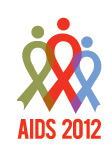 Have two HIV-positive stem cell transplant patients been cured of their infection? Several mainstream media headlines following a presentation by Boston researchers on Thursday, July 26, at the XIX International AIDS Conference (AIDS 2012) suggest they have. But while the case reports are intriguing and encouraging—both patients have undetectable blood- and cell-based virus and have been experiencing reductions in their HIV antibody levels following chemotherapy, stem cell transplants and while remaining on antiretroviral therapy following cancer diagnoses—references to a cure may be premature ("Two More Patients HIV-Free After Bone Marrow Transplants" reads an ABC News headline).
Have two HIV-positive stem cell transplant patients been cured of their infection? Several mainstream media headlines following a presentation by Boston researchers on Thursday, July 26, at the XIX International AIDS Conference (AIDS 2012) suggest they have. But while the case reports are intriguing and encouraging—both patients have undetectable blood- and cell-based virus and have been experiencing reductions in their HIV antibody levels following chemotherapy, stem cell transplants and while remaining on antiretroviral therapy following cancer diagnoses—references to a cure may be premature ("Two More Patients HIV-Free After Bone Marrow Transplants" reads an ABC News headline).
The latest case reports were reported by Timothy Henrich, MD, an infectious disease physician at Brigham and Women’s Hospital in Boston and his colleagues. He began by referencing the familiar case of Timothy Brown, colloquially known as the “Berlin Patient,” who was cured of his leukemia and HIV infection following high-dose chemotherapy and a stem cell transplant from a donor whose CD4 cells lacked the CCR5 receptor needed by HIV to establish infection.
Scientists hope to duplicate Brown’s outcome in other patients—notably those with certain cancers who require grueling stem cell transplants to save their lives—using CCR5-deficient stem cells from adult donors, cord blood samples and gene modification strategies (using zinc finger nucleases, for example).
Questions, however, still remain surrounding Brown’s case, notably: To what extent did his pre-transplant chemotherapy contribute to the destruction of the reservoirs of HIV in his body? Does graft-versus-host disease—the targeting of donors’ foreign immune system cells by transplant patients’ own cells—aid in eradicating reproducible virus?
Henrich’s team, in turn, wanted to explore the long-term effects of pre-conditioning chemotherapy and stem cell transplants in patients who didn’t receive cells from donors with HIV-susceptible cells. They focused on two Brigham and Williams patients who were living with HIV and underwent transplants for lymphoma-related cancers. But unlike Brown, they received transplants using cells expected to produce CD4s carrying the CCR5 receptor; they also received less-intensive chemotherapeutic pre-conditioning than Brown, so that they could remain on their antiretrovirals during and after the transplant process.
Both patients remained on ARVs while undergoing transplants—one was receiving Atripla (efavirenz/tenofovir/emtricitabine) the other was receiving Isentress (raltegravir) plus Truvada (tenofovir plus entrictabine)—and both were treated with immune-suppressive drugs following their transplants after experiencing grant-versus-host disease.
Looking back at blood samples collected from the patients during post-transplant follow up—one patient had roughly two years of samples available; the second had roughly three-and-a-half years of follow-up samples available—Henrich and his colleagues made a number of encouraging discoveries.
Using highly sensitive viral load technology, levels of replication-competent HIV—if it is still present—eventually became too low to be accurately measured, compared with what is typically seen in people receiving antiretroviral treatment ((less than a half copy per milliliter of blood plasma versus 1 to 2 copies per milliliter of blood plasma, respectively).
As for HIV-DNA inside cells in blood samples, Henrich and his group noted that genetic material was detected in the months following stem cell transplantation. But by day 200 in one patient and day 300 in the other, HIV-DNA became undetectable. In fact, efforts to “grow out” the virus in samples from the patients at day 1,266 and 652, respectively, proved fruitless.
While HIV antibodies are still detectable in both patients, substantial decreases in antibody levels began approximately 200 days following their transplants.
Are these patients cured of their HIV infection? While Henrich suggested the data are encouraging, noting the “substantial and sustained reduction in the HIV reservoir” and that the “declining HIV-specific antibody levels provide further evidence for minimal persistence of HIV antigen” are important findings, some key pieces of the puzzle are still missing.
Unlike Brown, who has remained off HIV treatment for more than five years and has produced tissue samples devoid of replication-competent HIV, the two patients under Henrich’s care have yet to initiate an antiretroviral treatment interruption and do not yet have tissue samples available. These are necessary, Henrich explained, “to fully assess the extent of HIV reservoir reduction after stem cell transplantation.”
“We’re being very careful to refer to our patients as not being functionally cured,” added Daniel Kuritzes, MD, a Harvard Medical School researcher who has been working alongside Henrich.
Advertisement
Advertisement
Advertisement






20 Comments
20 Comments